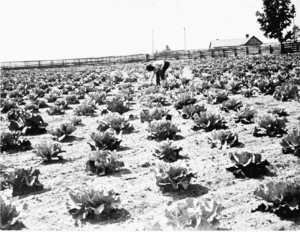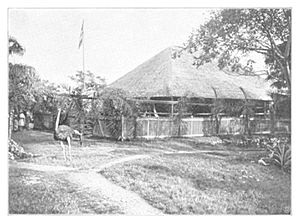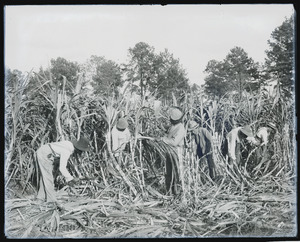James Nathan Calloway facts for kids
Quick facts for kids
James Nathan Calloway
|
|
|---|---|
| Born | 1865 Cleveland, Tennessee, US
|
| Citizenship | American |
| Alma mater | Fisk University |
| Scientific career | |
| Fields | Agriculture |
| Institutions | Tuskegee Institute |
James Nathan Calloway (born 1865) was an American expert in farming and agriculture. He was born into slavery in Tennessee. Calloway studied at Fisk University. After graduating, he joined the Tuskegee Institute. He first taught math. Later, he became very involved in farming science. In 1897, he became the manager of the institute's biggest farm.
In 1900, Calloway was chosen for a special trip. He went to German Togoland (now part of Togo and Ghana). His goal was to help grow more cotton there. Calloway developed a special type of cotton plant. This plant was perfect for the local conditions. He returned to the United States a year later. The special farm he started kept working until 1919. It helped cotton become a main crop in the area. Calloway went back to Tuskegee. He worked as a farm manager and taught agriculture until at least 1930.
Early Life and Education
James Nathan Calloway was born in 1865. He was born into slavery in Cleveland, Tennessee. His family later lived near Tuskegee, Alabama. He went to Fisk University in Tennessee. There, he learned German. He finished his studies and graduated in 1890.
Right after college, he started working at the Tuskegee Institute. This school helped educate African Americans in the Southern United States. Calloway began as a math teacher. In 1892, he became an inspector for the institute's Home Farm. This happened after George Washington Carver noticed problems with how the farm was run. Calloway reported that some crops, like tomatoes and sweet potatoes, were not well cared for. But he said the cabbage crops and dairy farm were doing well.
In 1893, Calloway became a business agent for the Institute. By 1897, he was made manager of the Marshall Farm. This was the institute's largest farm, covering about 800 acres.
The Cotton Project in Togo
In 1900, James Calloway was chosen to lead a special project. It was called the Tuskegee-Togo Cotton Scheme. The Tuskegee Institute worked with a German group called the Colonial Economic Committee. Their main goal was to teach Africans how to grow cotton. They also wanted to test different types of cotton. They hoped to create a strong, successful type of cotton.
The German government wanted their colony, Togoland, to grow a lot of cotton. This would help them rely less on cotton from America. The leader of the Tuskegee Institute, Booker T. Washington, agreed to help. He wanted to improve the lives of the African people. This project was important. It was the first time a major African American school worked on an economic or science project with a foreign country.
Before the trip, Calloway created a new type of cotton. This cotton was easier to spin and weave by machines. A German official described Calloway's role. He needed to have authority with the local people. He also needed to respect the German government officials. Calloway and three students from Tuskegee left New York on November 3, 1900. They traveled by boat and arrived in Togoland on January 1, 1901. They planned to set up a special farm to grow cotton in a place called Missahoe.
When they arrived, the local people did not want to pull the expedition's wagons. But they were happy to carry things on their heads. So, Calloway had to get animals like cattle and horses. These animals would carry the heavy loads. However, the animals died from Tsetse fly bites. This meant that people had to do the work. Four Togolese men pulled each plow. Thirty-six men pulled the cotton gin machine. This was a very difficult task for them. The farm also faced problems from insects like locusts and ants.
Calloway gave his special cotton seeds to the Togolese people. They were encouraged to sell their raw cotton. They were told not to weave it themselves. This would change cotton from a small home business to a big export crop. However, this idea was not popular. People felt it meant more work for less pay. The German officials sometimes had to use strict methods to make sure the project worked. The Tuskegee Institute had thought the people would be eager to join.
A three-year cotton school was started for local people. They learned about farming and how to use the cotton gin. In the first year, about 25 bales of cotton were produced. By 1903, this increased to 122 bales. Calloway left Togoland in 1901.
The project was hard on the Tuskegee students. Four out of eight students who went there died by 1909. Others went back home. Two students drowned in 1902 before even reaching Togoland. Student John W. Robinson led the project for some time. But he also drowned in a canoe accident in 1909. After that, no more Tuskegee students were sent. The special farm continued until 1919. The project did not fully meet Germany's goal. But it did make cotton a main crop in Togoland. It also helped the Togolese people gain more power.
Later Career and Family
After returning to the United States, Calloway went back to the Marshall Farm. By 1904, he was teaching 30 to 45 boys there. He continued to teach agriculture at Tuskegee until at least 1930.
Calloway had five children. One of his children was Nathaniel O Calloway. Nathaniel taught at the University of Illinois medical school. He also served as a major in the US Army Medical Corps during the Korean War. James Calloway's younger brother, Thomas Junius Calloway, also went to Fisk University. He was a friend of W. E. B. Du Bois. Another younger brother, Clinton Joseph Calloway, joined the agriculture department at Tuskegee when James was in Togoland.




